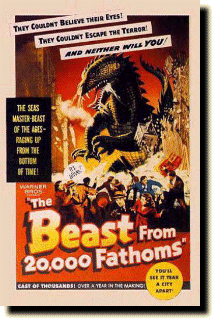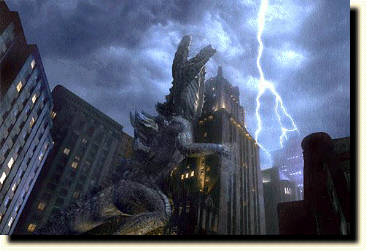![]()
![]()
 THE BEAST FROM 20,000 FATHOMS was Ray's first feature independently.
Besides the monumental task of developing the creature, designs, special
effects and story, Ray had to face drumming up the funding for this picture.
The producers of the film, Jack Deitz and Hal Chester has a treatment for
a film about a prehistoric monster they were calling MONSTER FROM BENEATH
THE SEA. Realizing the advantages of stop-motion in a low-budget picture
Ray was contacted for two reason. One because his work was very good and
two because they figured they could get hem a lot cheaper than Willis O'Brien.
Deitz and Chester also contacted a sci-fi writer and asked him to give them
his impression of the screenplay. That person was Ray Bradbury.
THE BEAST FROM 20,000 FATHOMS was Ray's first feature independently.
Besides the monumental task of developing the creature, designs, special
effects and story, Ray had to face drumming up the funding for this picture.
The producers of the film, Jack Deitz and Hal Chester has a treatment for
a film about a prehistoric monster they were calling MONSTER FROM BENEATH
THE SEA. Realizing the advantages of stop-motion in a low-budget picture
Ray was contacted for two reason. One because his work was very good and
two because they figured they could get hem a lot cheaper than Willis O'Brien.
Deitz and Chester also contacted a sci-fi writer and asked him to give them
his impression of the screenplay. That person was Ray Bradbury.
There are several different versions of the events that followed, depending on who you talk to. Both Ray Harryhausen and Ray Bradbury have slightly different versions but, to cut to the chase, Bradbury had published the short story THE BEAST FROM 20,000 FATHOMS in the Saturday Evening Post containing a sequence that was remarkably similar to the scene in the film where the Rhedosaurus attacks a lighthouse. Bradbury pointed out the similarities to Dietz and Chester who agreed to pay Bradbury something around $2,000 for the story. This story has since been reprinted as THE FOGHORN and is more familiar to Bradbury fans under that title. Unfortunately for sci-fi and fantasy fans, this was the only pairing of Ray Harryhausen and Ray Bradbury, both friends since their teens. It's difficult to imagine what would have happened if the two had officially paired, allowing Harryhausen to bring to life the vivid imagination of Bradbury, one of the sci-fi genre's greatest writers.
Ray went to work on conceptual drawings and then on the prehistoric beast itself. Ray explained that, for the film, several dinosaurs were combined to create this creature which he called the rhedosaurus. Finally getting the go ahead for the effects Ray set about to create so pretty impressive sequences for a film of this budget and for this time.
Ray's stop motion was not the only effect used for the dinosaur. Some sequences actually featured a seven inch long hand puppet that was used for close-up. Though not the preferred way for Harryhausen, budget limitations and time restrictions did not allow him to do all the effects the way he wanted. In the end, this is an impressive film with convincing effects despite the severe limitations that Ray was undergoing with the film.
The movie concerns an atomic explosion that releases a prehistoric beast that was frozen in the arctic circle. The beast is very much alive and begins to migrate to his breeding grounds, which happens to be off the shoreline of New York City. The only person who actually saw the creature can't seem to get anyone to believe him until a series of incidents that results in the destruction of a lighthouse and the sinking of several ships opens a military and scientific investigation. By that time the creature has reached New York and appears to be a little more than irate to discover the new inhabitants and buildings that are in his way. After toppeling a few buildings and eating several of New York's citizens, including a policeman, the creature is trapped in Coney Island where the military prepares to end it's existence. Amid a blazing fire and a terrific action sequence involving the famous Coney Island Roller Coaster, the creature meets his end.
The film was screened by Warner Brothers who released it in "glorious Sepia Tone" in the middle of the current 3-D and Cinemascope craze. Despite it's low budget limitations the movie caught on and Warner Brothers had a surprise hit on their hands. According to Dietz and Chester, the film was made for around $65,000 and was sold to Warner Brothers for $650.000. Warner invested another $200,000 to promote the film. It was released on June 1, 1953 to 500 theaters around the country. Three weeks later another 1000 screens were showing the film with the end result of a net profit of $2,500,000 in just America with another $2,500,000 in the overseas market.
Today, THE BEAST FROM 20,000 FATHOMS remains a cult hit because the story is adventurous and well-crafted with believable characters. The formula for the film would turn up quite often throughout the 1950's especially with a studio in Japan known as TOHO. Two years later GODZILLA would impact on the citizens of Japan and ,with some character changes, the story is very similar to THE BEAST FROM 20,000 FATHOMS. In 1998, Dean Devlin and Roland Emmerich released an updated version of GODZILLA. The new film had more in common with THE BEAST FROM 20,000 FATHOMS than the 1954 GODZILLA. Devlin and Emmerich, obviously fans of Harryhausen's films, pay several mini tributes to Rays body of work, including a clip from IT CAME FROM BENEATH THE SEA. However, one scene in particular is an excellent recreation of the lighthouse sequence:

While there would be many Godzilla's to follow, Ray's Rhedosaurus would be put to sleep for good, making way for the next fantastic monster, the six-tentacled giant octopus (or is that sextopus). For more on that see IT CAME FROM BENEATH THE SEA.
| CAST AND CREDITS |
SYNOPSIS | BEHIND THE
SCENES |
| POSTERS
| IMAGES |
SOUNDS |
BEAST FROM 20,000
FATHOMS STORE

|
Profile
|
Filmography
|
Collectibles
|
Misc.
| King
Kong Event|
Please e-mail and let me know what you think. I'm open to any
comments or suggestion that you think would help this page.
 send email to Jim
Rodkey.
send email to Jim
Rodkey.